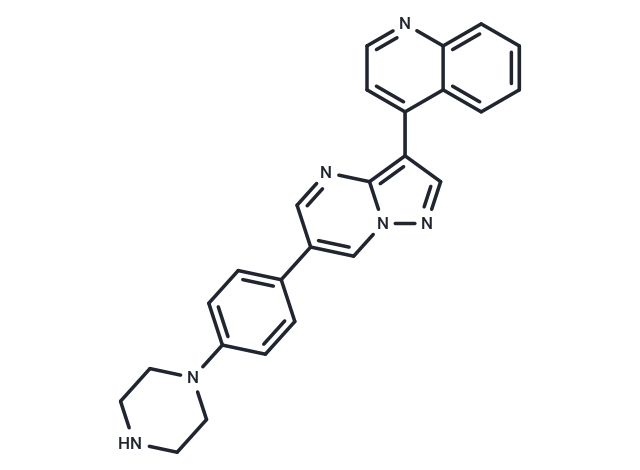Shopping Cart
- Remove All
 Your shopping cart is currently empty
Your shopping cart is currently empty

LDN193189 (LDN-193189) (DM 3189) is a selective BMP signaling inhibitor, inhibiting the transcriptional activity of ALK2 and ALK3 (IC50s: 0.8/0.8/5.3/16.7 nM for ALK1/2/3/6).

| Pack Size | Price | Availability | Quantity |
|---|---|---|---|
| 2 mg | $41 | In Stock | |
| 5 mg | $67 | In Stock | |
| 10 mg | $87 | In Stock | |
| 25 mg | $148 | In Stock | |
| 50 mg | $237 | In Stock | |
| 100 mg | $353 | In Stock | |
| 200 mg | $523 | In Stock |
| Description | LDN193189 (LDN-193189) (DM 3189) is a selective BMP signaling inhibitor, inhibiting the transcriptional activity of ALK2 and ALK3 (IC50s: 0.8/0.8/5.3/16.7 nM for ALK1/2/3/6). |
| Targets&IC50 | ALK3:30 nM (C2C12 cells), ALK2:5 nM (C2C12 cells) |
| In vitro | LDN-193189 inhibited BMP4-mediated Smad1, Smad5 and Smad8 activation (IC50: 5 nM). LDN-193189 efficiently inhibited the transcriptional activity of the BMP type I receptors ALK2 and ALK3 (IC50s: 5/30 nM), with substantially weaker effects on activin and the TGF-β type I receptors ALK4, ALK5 and ALK7 (IC50 ≥ 500 nM). LDN-193189 inhibited the induction of alkaline phosphatase activity in C2C12 cells by BMP4 even when administered 12 h after BMP stimulation [1]. Treatment of human aortic endothelial cells with LDN-193189 abrogated the production of reactive oxygen species induced by oxidized LDL. Treatment of mice with LDN-193189 lowered LDL serum cholesterol by 35% and markedly decreased hepatosteatosis without inhibiting HMG-CoA reductase activity. Treatment with BMP2 increased, whereas LDN-193189 inhibited apolipoprotein B100 secretion in HepG2 cells [2]. |
| In vivo | Treatment of Ad.Cre-injected, caALK2-expressing mice with LDN-193189 (3 mg/kg i.p. every 12 h) prevented radiographic lesions at P15 in all mice examined. At P30, LDN-193189 prevented ectopic bone in approximately two-thirds of mice and attenuated lesions in the remainder, whereas at P60 LDN-193189 prevented ectopic bone in one-third of mice and attenuated lesions in the remainder. In contrast to vehicle-treated mice, LDN-193189–treated mice appeared to preserve knee and ankle joints at P30 and P60 [1]. Prolonged treatment of LDLR-/- mice with LDN-193189 was well-tolerated and potently inhibited development of atheroma, as well as associated vascular inflammation, osteogenic activity, and calcification [2]. Treatment of SCID mice bearing MDA-PCa-118b tumors with LDN-193189 significantly reduced tumor growth [3]. |
| Cell Research | C2C12 cells were seeded into 96-well plates at 2,000 cells per well in DMEM supplemented with 2% FBS. We treated the wells in quadruplicate with BMP ligands and LDN-193189 or vehicle. We collected the cells after 6 d in culture in 50 μl Tris-buffered saline and 1% Triton X-100. We added the lysates to p-nitro-phenylphosphate reagent in 96-well plates for 1 h and then evaluated alkaline phosphatase activity (absorbance at 405 nm). We measured cell viability and quantity by Cell Titer Aqueous One (absorbance at 490 nm), using replicate wells treated identically to those used for alkaline phosphatase measurements [1]. |
| Animal Research | In the first experiment, SCID mice were implanted with MDA-PCa-118b tumors. After 7 days when tumors reached measurable sizes, mice were injected with LDN-193189 (3 mg/kg) or with vehicle intraperitoneally twice a day. Tumor sizes and body weights were measured weekly. Mice were injected with calcein at three days and one day prior to sacrifice. Blood was collected and tumors were weighed. A portion of the tumors were fixed in formaldehyde for micro-computed tomography, using EVS CT, or further decalcified for bone histomorphometric analysis, using the OsteoMeasure Analysis System, or flash frozen for RNA preparation. Osteocalcin in the mouse serum was determined by ELISA. In the second experiment, PCa-118b tumors were first digested with Accumax, and the isolated cells were plated overnight, digested by Accutase, resuspended in Matrigel in 1:1 ratio, and injected into SCID mice (1 × 10^6 cells/mouse) subcutaneously. Mice were treated with LDN-193189 five days post-injection [3]. |
| Alias | LDN-193189, LDN 193189, DM-3189 |
| Molecular Weight | 406.48 |
| Formula | C25H22N6 |
| Cas No. | 1062368-24-4 |
| Smiles | C1CN(CCN1)c1ccc(cc1)-c1cnc2c(cnn2c1)-c1ccnc2ccccc12 |
| Relative Density. | 1.33 g/cm3 |
| Storage | Powder: -20°C for 3 years | In solvent: -80°C for 1 year | Shipping with blue ice. | ||||||||||
| Solubility Information | H2O: Insoluble DMSO: 1.45 mg/mL (3.56 mM), when pH is adjusted to 2 with HCl. Sonication is recommended. 0.01M HCL: 1.67 mg/mL (4.11 mM), Sonication is recommended. | ||||||||||
Solution Preparation Table | |||||||||||
DMSO/0.01M HCL
| |||||||||||

Copyright © 2015-2025 TargetMol Chemicals Inc. All Rights Reserved.